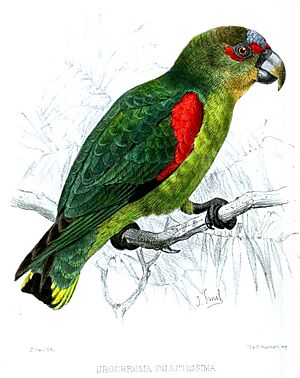Blue-fronted parrotlet facts for kids
Quick facts for kids Blue-fronted parrotlet |
|
|---|---|
 |
|
| Illustration by Joseph Smit, 1870 | |
| Conservation status | |
| Scientific classification | |
| Genus: |
Touit
|
| Species: |
dilectissimus
|
 |
|
| Synonyms | |
|
Urochroma dilectissima |
|
The blue-fronted parrotlet (Touit dilectissimus) is a small, colorful parrot. It belongs to the Psittacidae family, which includes parrots from Africa and the Americas. You can find this bird in countries like Colombia, Ecuador, Panama, and Venezuela.
Contents
About This Parrot
The blue-fronted parrotlet is a unique type of parrotlet. It is the only species in its group, meaning it doesn't have any subspecies. Scientists sometimes thought it was the same as the red-fronted parrotlet. However, they are now known to be separate but closely related species.
What Does It Look Like?
The blue-fronted parrotlet is about 17 to 18 centimeters (7 inches) long. It weighs between 59 and 71 grams (2 to 2.5 ounces). Most of its body is green, with darker green on its back.
Its forehead, or "front," is bright blue. It has a white ring around its eye. There is a red line in front of and below its eye, with more blue below that. The top of its head and the back of its neck are a bronze-green color.
This parrot has a lot of red on its wing near the "wrist" area. Its main flight feathers are black with green edges. The feathers under its wings are yellow. Its middle tail feathers are black, and the others are yellow with black tips. Male parrotlets have more red on their wings than females. Young parrotlets look like females but have less clear face markings.
Where Does It Live?
The blue-fronted parrotlet lives in several South American countries. You can find it from eastern Panama down the Pacific coast of Colombia and Ecuador. It lives as far south as El Oro Province in Ecuador. It also lives in the Andes mountains and the Serranía del Perijá in Venezuela.
These birds prefer to live in cloudforests and old, grown-up secondary forests. In the Andes, they usually live at heights between 500 and 1,400 meters (1,600 to 4,600 feet). Sometimes, they can be found as low as 100 meters (330 feet). In Colombia, they often live up to 2,000 meters (6,600 feet) high. In Venezuela, they are mostly found between 1,300 and 1,600 meters (4,300 to 5,200 feet). They have even been seen as high as 3,000 meters (9,800 feet). Their groups are spread out across their large home range.
How Does It Behave?
Blue-fronted parrotlets are social birds. They often live in small groups of up to 15 individuals. When they are eating or resting in tree branches, they are usually quiet. This makes them hard to spot. However, they can be very noisy when they are flying. You might see them more often at the edge of a forest.
Moving Around
These parrotlets move from place to place depending on the season. They travel from their main living areas to lower lands and higher mountain spots.
What Does It Eat?
Scientists don't know much about what blue-fronted parrotlets eat. Some studies of their stomachs found small fruits. It's not clear if they eat the fruit itself or the seeds inside. They have been seen eating seeds from fruits of the Clusiaceae plant family.
How Does It Breed?
In Panama, blue-fronted parrotlets seem to breed in May and June. In Colombia, their breeding season includes March and June, but it's not fully known. The few nests that have been found were dug into termite nests in trees. One nest in Colombia was about 7 meters (23 feet) above the ground.
What Sounds Does It Make?
The most common calls of the blue-fronted parrotlet are a slightly nasal "chree" or a two-part "chu-ree." When flocks fly together, they call at the same time. This creates a continuous, noisy chattering sound. When they are sitting on a branch, they also make a soft, purring "krr" sound.
Is It Endangered?
The IUCN (International Union for Conservation of Nature) says the blue-fronted parrotlet is a species of "Least Concern." This means it is not currently at high risk of becoming extinct. It lives in a large area, but its total population size is unknown. Scientists believe its numbers might be going down.
No major threats have been found for this parrot. It is considered "uncommon to rare." However, there is still a lot of habitat left for it. Also, not many of these birds are caught for the pet trade. This means the species is relatively safe for now.


